- Home
- Timothy Egan
The Good Rain: Across Time & Terrain in the Pacific Northwest
The Good Rain: Across Time & Terrain in the Pacific Northwest Read online
Timothy Egan’s
THE GOOD RAIN
The secret of life in the Northwest runs in packs of silver; as with most mysteries, it lies just below the surface, evident to anyone who thinks it important enough to look. At Willamette Falls, this secret reveals itself in rare flashes amidst the industrial clutter of Oregon City. The river here is a beast of burden, powering the street lights of nearby Portland, grinding wood pulp to paper, settling into locks that lift ships on their way. Against this metallic frenzy a few chinook salmon hurry upstream, driven by a singular impulse to pass on the baton of life and then die. To the continued befuddlement of biologists, they return to the neighborhood of their youth after seeing the world. In the fall, as the ground goes cold and the fields die, they bring a dose of fertility in from the sea, carrying the collected natural history of the Willamette in their gene pool. Fornication, in the ritualized style of the Pacific salmon, is never more charitable—or fatal.
FIRST VINTAGE DEPARTURES EDITION, DECEMBER 1991
Copyright © 1990 by Timothy Egan
Maps copyright © 1990 by George Colbert
All rights reserved under International and Pan-American Copyright Conventions. Published in the United States by Vintage Books, a division of Random House, Inc., New York, and simultaneously in Canada by Random House of Canada Limited, Toronto. Originally published in hardcover by Alfred A. Knopf, Inc., New York, in 1990.
Library of Congress Cataloging-in-Publication Data
Egan, Timothy.
The good rain : across time and terrain in the Pacific
Northwest / Timothy Egan.—1st Vintage departures ed.
p. cm.—(Vintage departures)
Originally published: New York : Knopf, 1990.
eISBN: 978-0-307-79471-0
1. Northwest, Pacific—Description and travel. 2. Northwest,
Pacific—History. 3. Landscape—Northwest, Pacific.
I. Title.
[F851.E28 1991]
979.5—dc20 91-50028
Author photograph by Joni Balter
v3.1
To my mother,
who always said, Stay West,
and then showed me why
The flora and fauna grew or died, flourished or failed, in complete disregard for man and his aims. A Man Can Make His Mark, did they tell me? Lies, lies. Before God I tell you: a man might struggle and labor his livelong life and make no mark! None! No permanent mark at all! I say it is true.
KEN KESEY, Sometimes a Great Notion
Contents
Cover
Title Page
Copyright
Dedication
Epigraph
Acknowledgments
Introduction Finishing Up With Grandpa
Chapter One The Continental Heave
Chapter Two Enchanted Valley
Chapter Three Toe of the Empire
Chapter Four The Last Hideout
Chapter Five With People
Chapter Six Natives
Chapter Seven Friends of the Hide
Chapter Eight Under the Volcano
Chapter Nine The Wood Wars
Chapter Ten Salmon
Chapter Eleven Harvest
Chapter Twelve God’s Country Cancer
Chapter Thirteen Columbia
Epilogue Pacific Nation
Acknowledgments
Writing may be a solitary pursuit, but building a book is collaborative. Support, both inspirational and informational, came from Joni Balter, Wallace Turner and Joel Connelly in Seattle. Through their writings, Bruce Brown, Bill Dwyer, Murray Morgan, Emmett Watson and the late William O. Douglas helped to point me in the right direction. I’m grateful to Carol Mann in New York for her superb job of editorial matchmaking. I would also like to thank my editors at the New York Times, particularly Soma Golden and Jon Landman, for allowing me the time to try and get it right. Finally, I owe my biggest debt to Ash Green at Knopf.
T.E.
Introduction
FINISHING UP WITH GRANDPA
All summer long Grandpa remains in the basement, two pounds of cremated ash in a plain cardboard cylinder. I can’t get used to the idea of this odorless beige powder as the guy who taught me how to land brook trout with a hand-tied fly, the son of a Montana mineral chaser, the teller of campfire tales about hiding from the Jesuits with his schoolboy chum, a jug-eared kid named Bing Crosby. He had smoked himself to death, and near the end Grandpa couldn’t even take a pee without falling down and gasping for breath. He’d be lying on the bathroom floor of his house in Seattle, a plastic-tipped cigar clenched between his teeth, all that loose skin draped over a shrinking body. Fifty years of two packs a day, that’s what did it. Finally, the emphysema literally asphyxiated him. He was as old as the twentieth century when he died.
My job is to bury him. Something appropriate, my Granny says, handing me the cylinder after the funeral. “Just throw him off the ferry or dump him into the Yakima River,” she says. “Whatever you think is best.”
This sends me to the map. He’d fished every stream of substance on both sides of the Cascade Mountains, and when the Winnebagos and ghetto blasters began to invade the trout haunts close to home, he went north to British Columbia in search of the adrenal surge that came every time a foot-long native cutthroat rose from the glacial chill to snap one of his tricolored nymphs. With his hip-waders, history books and flasks of Murphy’s, he wandered from the crest of the Canadian Rockies to the mean edge of the Pacific, following fish. As I think about what to do with him now, a river seems a logical last home. Like the chinook salmon that swim eight thousand miles from the Siberian shore to mate and then die in the same Cascade Mountain stream in which they were born, he needs to return, full cycle. But where, exactly?
Stumped for the time being, I set Grandpa on a stool in the basement of this tired house we are renting near Lake Washington. Joni and I live upstairs, but we have to pass through the basement in order to get outside. This means the what-to-do-with-Grandpa question is at least a twice-a-day nuisance. As the summer dries out and the pink glow off the western glaciers of Mount Baker disappears earlier and earlier, I begin to feel like a spiritual delinquent, holding up a long-planned reunion of body and soul.
Mid-fall now, the leaves of the red maple out front are clinging to a thread of memory, and we know he has to go. A winter with Gramps in the basement will not do. On a Sunday in late October, one of those weekends when the jet stream is lacerating southeast Alaska but leaving this corner of continental America alone, we put Grandpa in the car and drive south, heading for Mount Rainier. I decide to take him to the apex of the Northwest, the blue hulk which has shadowed over both of us for so long. The volcano of Rainier, I conclude, is where he belongs.
The road follows the water, beginning in Seattle, where Lake Washington is fed by the Cedar River, a point which used to be the favorite summer camp for the salmon-fat Duwamish Indians. Now, it’s covered with Boeing barns stuffed with generic-green 737s and 757s. In his time, Grandpa could still fish the Cedar as it snaked toward the lake; he could take a ferry for a Sunday picnic in the park of Mercer Island; he could climb up the hills just east of the lake, the first swelling of the Cascades, and maybe see a cougar, or at least a few elk among the stands of hemlock and spruce. It’s all highway and cul-de-sac now: the Cedar River straightened in parts by those orthodontists of nature, the Army Corps of Engineers; Mercer Island cut by ribbons of the most expensive freeway ever built and bridged by two of the world’s longest floating spans; and the hills shaved and shorn of their five-hundred-year-old trees to make way f
or the waves of California exiles seeking a slice of paradise in a metropolis where insider-trading is not yet required in order to afford a first mortgage.
We follow the Cedar for twenty miles or more, until Rainier comes into sudden view, rising nearly three vertical miles above the dairy farms of Enumclaw. Here the valley is wide and oddly level, as if the Corps has been here earlier, correcting some quirk of nature which didn’t match an Army engineer’s blueprint. The flat valley is Rainier’s own doing, the result of the largest mudflow ever known, a slide which eventually took with it the top two thousand feet of the mountain and spread a swath of broken basalt and clay for forty-five miles down the valley.
Past Enumclaw the road begins to climb, winding through fresh-shaved forest land, denuded in the modern style of the timber industry, and then picks up along the milky way of the White River. “Glacial piss” is what some fishermen call the White River—colder than a football trainer’s icepack, the color of thin milk. Into this river Grandpa will go, or pass through; its source, like most of the water in these parts, is high up on Rainier, locked in another molecular form.
An hour’s drive from Seattle we enter the national park, nearly 250 square miles of protected scenery, thanks in large part to those twin demons of turn-of-the-century timber barons, Theodore Roosevelt and John Muir. Roosevelt helped stir up populist sentiment, thundering against land-grabbers and tree-shavers; in turn, they named an elk after him. The prolific Muir, a naturalist who could massage a phrase as very few scientists can, provided the push from the pen. Muir’s name is attached to the 10,000-foot-high camp on the most popular climbing route to Rainier’s 14,410-foot summit. On summer weekends, Camp Muir is not unlike a small mining town on a roll, full of climbers laden with gear and seeking glory in higher ground. Old Man Muir, dragging around a beard that went past his navel, had a sense of humor not always evident among some of his modern-day followers. But he would most likely disapprove of the odd distinction the camp named after him has gained: it is the site of the world’s most expensive outhouse, a $50,000 solar shitter which uses high-altitude ultraviolet rays to cook and compost climbers’ waste.
My intention is to toss Grandpa’s remains on the east side of the mountain, away from Camp Muir, so the ashes will scoot with Rainier’s runoff until they blend with the trout streams below. First, though, I have to get him to the high point of the White River, where the drip of glacier melt and gravity conspire to form a common flow. We park the car at Sunrise Lodge, 6,400 feet above sea level, just below timberline, facing a crest of the Cascades where William O. Douglas roamed as a boy. The late Supreme Court Justice, a thin-haired noodle of a man who favored lonely alpine meadows and young wives, was that rare breed from another time, the Renaissance Man of the American West: lawyer, author, outdoorsman, lover. He was equally at home under a dripping canvas pup tent or in the halls of New York’s Museum of Modern Art. In his later years, the sage of Goose Prairie, a hamlet just over the crest, was quite worn down; paranoid in the Nixon era, he feared that the FBI would grow marijuana plants on his Cascade Mountain ranch in an effort to trap him. In fitting tribute, a large tract of wild country that surrounds Goose Prairie is now the William O. Douglas Wilderness. The growing season is too short, the winds too harsh, for pot, something the FBI or a good defense lawyer would soon have learned.
The old visitors center at Sunrise is closed for the season. The grass nearby has the stiff, brown look of vegetation which has felt the sting of first frost. We find a trail leading up to the headwaters of the White River, Grandpa in the pack on my back, Joni carrying a bottle of a local Chardonnay. The day, by midmorning, is as bright as a calendar page. The huckleberry bushes are aflame, low red borders holding berries sweetened by the chill set against subalpine spruce. The cold nights have not been enough to freeze up the tarns and small lakes filling scooped-out bowls along the way. Here and there, deer poke around the edges.
After a thousand feet or so of elevation gain, the 12,307-foot summit of Mount Adams first appears to the southeast, in and out of view as we scale the ridges, its ice crown shining like a bald man doing chin-ups in the morning sun. Adams, in most other parts of the world, would be revered, a national park at least; here, in an area once said to have enough mountain scenery to fill a half-dozen Switzerlands, it is a seldom-visited sentinel in a ravaged land. Weyerhaeuser, the world’s biggest lumberjack, owns most of the land between here and Mount Adams, at least that which is not ice or rock. They’ve left their usual calling cards, stumps and clearcuts.
We are breathing heavily now, taking in the chill air and exhaling exuberance. I kiss Joni, a native of Pittsburgh, where the rivers struggle to hold some hint of natural life. With every step upward, I feel a deeper attachment to this land. The trail peters out, disappearing among rock and wind-blown moraine dust. A few bony tufts of tree, polished skeletons at the edge of the alpine zone, protrude from the hard ground. At glacier’s edge, several thousand feet above the White River valley, nothing grows or lives. In just over an hour, we have passed from full-throttled vegetation of the lower forest to the dead zone. We half-step our way to a rocky edge worn and wrinkled by the persistent moisture. Below, the valley drops steeply; a shout takes several seconds to land, and then bounces away.
“Here,” I say to Joni. “This is the place.” We laugh, both realizing the echo of Brigham Young, multiple wives and a caravan of zealots in tow, when he crossed the Wasatch Range and used those same words, now immortalized on the statue in the center of Salt Lake City.
I take out my map, the sweat atop my forehead dripping, and follow the glacier fingers down the summit. We are close to the Emmons Glacier, the longest ice mass in continental America, four miles of frozen precip, at its core as deep as the Seattle Kingdome from playing field to roof. I trace the glacier on the map and see that it is not the Emmons which feeds the White River. A lesser glacier, the Winthrop, appears to be the source.
I take Grandpa out of the pack and set him next to a rock. No wind. From below comes a marmot whistle, a high pierce. I think: Winthrop. What is an old Puritan’s name doing up here, on the frozen side of a mountain that wasn’t even spotted by white men until after the Revolutionary War? What cartographer’s trick, or cheap flattery, placed the name Winthrop here, a country of noble Indian names—Tacoma, the original word for this mountain; Sluiskin Falls, named for the native who first led whites to the demon-dwelling pit of fire at the summit; Ohanapecosh, where the rivers meet below. Most of the English names were coined by syphilitic prospectors and timber beasts—the Frying Pan Glacier, Old Scab Mountain, Anvil Rock, Panhandle Gap. Why Winthrop? It’s too genteel for this massive chunk of glacial anarchy, like an Eskimo in an Izod.
I will investigate later. Now, I’m shivering, the sweat turning cold on my skin. I put on a vest while Joni opens the wine. We sip, and soak in the scenery, seeking the rhythm of late October at eight thousand feet, the countryside slow to close down for the winter. I eat some smoked salmon, bread, an apple, drink more wine, all products of this land.
When he died, Grandpa was almost fifty years older than I, and I now wonder about my life at full term. This country of misted forests and untouched islands, of living volcanoes and a tidal shoreline that would stretch from Seattle to New York and back if laid out, has changed so much in the course of his lifetime. Holding Grandpa, his eighty years reduced to these ashes in a cylinder, I realize we have gone from the canoe to the hydrofoil, from cedar longhouse to thousand-foot-high skyscraper, in slightly more than the span of his life. Despite the material insulation in which we wrap ourselves, these tousled forests and ocean currents pushing through inland passages still determine how we live; the landscape overwhelms. We are not that removed—yet—from the arms of the land.
I do not live in the Northwest, nor did he, out of habit, although that is part of it. There are just under 12 million people in Washington, Oregon, Idaho and British Columbia, a bit more than the population of Sweden, and most of them live within
one hour of the mountains. In the last light of day we can look up, from the low point of urban stress, and see the high point of outdoor relief—the natural neon of alpenglow. Is that the connective link from his generation to mine?
The wind has picked up some. A cloud cap, one of Rainier’s mood halos, hustles over the summit. Joni is shivering. My ears are numb. It’s time to finish up with Grandpa. I open the cylinder and stand. We say nothing, although she smiles. Solemnity does not fit either of us for long; like an itchy sweater, it is soon discarded. I tiptoe out to the edge of the rock. The wine, at this elevation after hard work, has made my head light and my feet slow to react. I swing back all the way and toss the ashes out. They shoot up and then curve down in a grand arc, a sepia-toned rainbow, stretching from this glacial edge to the dawning trickle of the White River, a thousand feet or more below. We watch until all the ashes have scattered from view. And then we say Goodbye.
In Seattle, I go to the library and look for something about Winthrop. I will face queries from family members, and I want to know as much as possible about this source of the White River. The Winthrop Glacier, says a thick, valuable book called Place Names of Washington, was so named by Theodore Winthrop during his summer visit to the Pacific Northwest in 1853. It must’ve been nice to be a tourist in those days: instead of returning home with a credit-card debt and a suitcase full of “I’m With Stupid” T-shirts, you left a legacy—peaks and rivers and glaciers named on whim. Theodore Winthrop was the great-great-great-grandson of John Winthrop, first governor of the Massachusetts Bay Colony, the original Puritan. A stuffed shirt, a humorless Yankee, I presume, out to manifest his destiny in a still-unspoiled part of the frontier.
Further investigation leads me to the The Canoe and the Saddle, Winthrop’s account of the three months he spent in the Northwest that summer. At the time, he was twenty-five years old, well traveled and looking for fresh adventure, a Yale graduate who called himself a writer, and a humorist at that—he had yet to shake a tag as the family gadfly. I go to the oldest bookstore in Seattle, Shorey’s, and ask about The Canoe and the Saddle. The clerk looks up from a written ledger (there is nothing even remotely late-twentieth-century about this bookstore) and smiles broadly. That book, he tells me, is not only one of the first ever written about the Pacific Northwest, but one of the best, to this day.

 The Immortal Irishman
The Immortal Irishman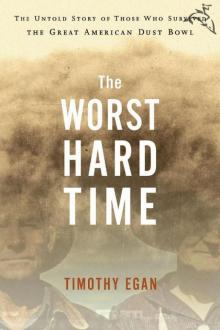 The Worst Hard Time: The Untold Story of Those Who Survived the Great American Dust Bowl
The Worst Hard Time: The Untold Story of Those Who Survived the Great American Dust Bowl The Good Rain: Across Time & Terrain in the Pacific Northwest
The Good Rain: Across Time & Terrain in the Pacific Northwest Breaking Blue
Breaking Blue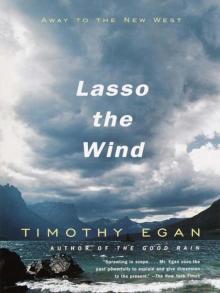 Lasso the Wind: Away to the New West
Lasso the Wind: Away to the New West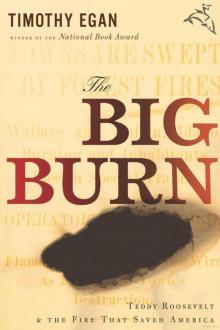 The Big Burn: Teddy Roosevelt and the Fire That Saved America
The Big Burn: Teddy Roosevelt and the Fire That Saved America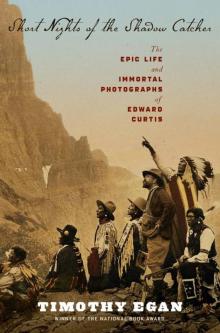 Short Nights of the Shadow Catcher
Short Nights of the Shadow Catcher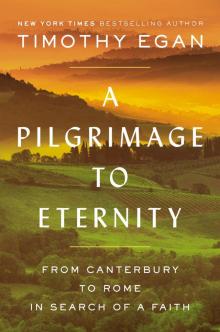 A Pilgrimage to Eternity
A Pilgrimage to Eternity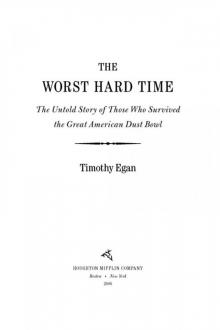 The Worst Hard Time
The Worst Hard Time The Big Burn
The Big Burn